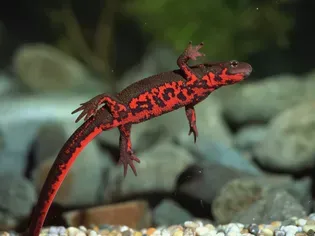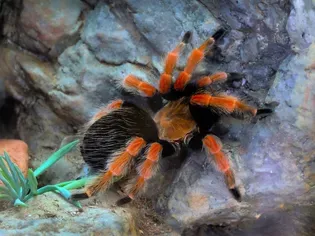Fire Belly Newt: Species Profile
Updated on 04/26/24

Unveiling the Enchanting Fire Belly Newt: A Comprehensive Species Profile
Prepare to be captivated by the captivating beauty and intriguing life history of the fire belly newt, a charismatic amphibian that has captured the hearts of nature enthusiasts worldwide. This comprehensive species profile delves into every fascinating aspect of these remarkable creatures, from their vibrant coloration to their unique adaptations and captivating behaviors. Whether you're an aspiring herpetologist or simply captivated by the wonders of the natural world, this in-depth exploration will ignite your curiosity and leave you awe-inspired.
A Symphony of Colors: The Fire Belly Newt's Captivating Appearance
The fire belly newt derives its name from its vibrant ventral coloration, a fiery hue that ranges from bright orange to a deep, mesmerizing red. This striking coloration serves as a warning to predators, advertising the newt's toxicity. The dorsal surface of the newt, in contrast, displays a more muted palette of olive green to brown, providing camouflage amidst its natural surroundings.
While the fire belly newt's coloration may vary geographically, the vividness of its ventral surface remains a constant, making it one of the most recognizable amphibians in its range.
Exceptional Adaptations: The Fire Belly Newt's Survival Toolkit
Evolution has bestowed upon the fire belly newt an array of remarkable adaptations that enhance its survival in diverse habitats.
- Poisonous Skin: The newt's skin secretes a potent neurotoxin called tetrodotoxin, which acts as a powerful deterrent against predators. This toxin, concentrated in the newt's skin glands, can cause paralysis and even death to animals that attempt to consume it.
- Regenerative Tail: The fire belly newt possesses an extraordinary ability to regenerate lost or damaged body parts, including its tail. This remarkable adaptation allows the newt to escape predators by sacrificing a portion of its tail while the rest of its body remains unharmed.
- Aquatic and Terrestrial Life: The fire belly newt exhibits a unique ability to thrive in both aquatic and terrestrial environments. During the breeding season, it can be found in ponds, lakes, and other bodies of water. As the season progresses and water levels diminish, the newt transitions to a terrestrial lifestyle, seeking shelter under logs, rocks, and leaf litter.
Intricate Behaviors: A Glimpse into the Fire Belly Newt's World
Beyond its captivating appearance and remarkable adaptations, the fire belly newt's behaviors offer a captivating window into its complex life history.
- Courtship Ritual: During the breeding season, male fire belly newts engage in elaborate courtship rituals to attract females. These rituals involve intricate tail-wagging displays and the release of pheromones to entice potential mates.
- Egg Laying: Once a female newt has selected a mate, she will deposit her eggs in aquatic vegetation. These eggs, encased in a protective jelly, undergo development until hatching into tiny, free-swimming larvae.
- Metamorphosis: The fire belly newt undergoes a series of dramatic transformations throughout its life cycle. After hatching from eggs, the larvae develop gills and a tail, resembling miniature fish. As they mature, they undergo metamorphosis, losing their gills and developing lungs, and transitioning to a terrestrial existence.
Conservation Concerns: Preserving the Fire Belly Newt's Legacy
As human activities continue to reshape the planet, the fire belly newt faces a variety of conservation challenges. Habitat loss, pollution, and climate change pose significant threats to its survival.
- Habitat Loss: Urban development, agriculture, and other land-use changes have significantly reduced the fire belly newt's natural habitats, fragmenting populations and making them more vulnerable to extinction.
- Pollution: Industrial and agricultural pollutants can contaminate water bodies where fire belly newts breed, affecting their health and reproductive success.
- Climate Change: Rising global temperatures and changes in precipitation patterns can alter the newt's habitat and disrupt its life cycle.
Conservation efforts are crucial to ensure the long-term survival of this captivating species. Protecting and restoring habitats, reducing pollution, and mitigating the impacts of climate change are essential steps towards preserving the legacy of the fire belly newt.
Conclusion: A Tapestry of Wonder and Conservation
The fire belly newt, with its vibrant coloration, remarkable adaptations, and intriguing behaviors, stands as a testament to the boundless wonders of the natural world. Its existence is a delicate balance, influenced by a myriad of factors. By understanding and appreciating the unique attributes of this captivating species, we can become stewards of its survival and ensure that future generations can experience its enchanting presence.
Explore More Pets

Exotic Pet Species
Should You Keep a Chimpanzee as a Pet?

Exotic Pet Species
Should You Keep a Raccoon as a Pet?

Exotic Pet Species
How to Care for a Pet Mexican Red-Knee Tarantula

Exotic Pet Species
12 Best Exotic Pets for Apartment Living

Exotic Pet Species
Best Foxes to Keep as Pets

Exotic Pet Species
Should You Keep a Northern Flying Squirrel as a Pet?

Exotic Pet Species
Should You Keep Stick Insect as a Pet?

Exotic Pet Species
Should You Keep a Big Cat as a Pet?